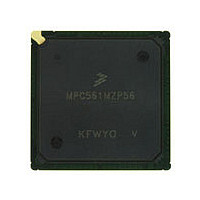MPC561MZP56 Freescale, MPC561MZP56 Datasheet - Page 151

MPC561MZP56
Manufacturer Part Number
MPC561MZP56
Description
Manufacturer
Freescale
Datasheet
1.MPC561MZP56.pdf
(1420 pages)
Specifications of MPC561MZP56
Cpu Family
MPC56x
Device Core
PowerPC
Device Core Size
32b
Frequency (max)
56MHz
Interface Type
QSPI/SCI/SPI/UART
Total Internal Ram Size
32KB
# I/os (max)
56
Number Of Timers - General Purpose
22
Operating Supply Voltage (typ)
2.6/5V
Operating Supply Voltage (max)
2.7/5.25V
Operating Supply Voltage (min)
2.5/4.75V
On-chip Adc
2(32-chx10-bit)
Instruction Set Architecture
RISC
Operating Temp Range
-40C to 125C
Operating Temperature Classification
Automotive
Mounting
Surface Mount
Pin Count
388
Package Type
BGA
Program Memory Type
ROMLess
Program Memory Size
Not Required
Lead Free Status / RoHS Status
Not Compliant
Available stocks
Company
Part Number
Manufacturer
Quantity
Price
Company:
Part Number:
MPC561MZP56
Manufacturer:
Freescale Semiconductor
Quantity:
10 000
Company:
Part Number:
MPC561MZP56R2
Manufacturer:
Freescale Semiconductor
Quantity:
10 000
- Current page: 151 of 1420
- Download datasheet (11Mb)
Adherence to the PowerPC ISA architecture can be measured in terms of which of the levels are
implemented.
3.6
The PowerPC ISA architecture defines register-to-register operations for most computational instructions.
Source operands for these instructions are accessed from the registers or are embedded in the instruction
opcode. The three-register instruction format allows specification of a target register distinct from the two
source operands. Load and store instructions transfer data between memory and on-chip registers.
PowerPC ISA-compliant processors have two levels of privilege: supervisor mode (typically used by the
operating environment) and user mode (used by the application software). The programming model
incorporates 32 GPRs, special-purpose registers (SPRs), and several miscellaneous registers.
Supervisor-level access is provided through the processor’s exception mechanism. That is, when an
exception is taken (whether automatically, because of an error or problem that needs to be serviced, or
deliberately, as in the case of a trap instruction), the processor begins operating in supervisor mode. The
access level is indicated by the privilege-level (PR) bit in the machine state register (MSR).
Figure 3-3
of the PowerPC ISA architecture. Note that registers such as the general-purpose registers (GPRs) are
accessed through operands that are part of the instructions. Registers can be accessed explicitly through
specific instructions such as move to special-purpose register (mtspr) or move from special-purpose
register (mftspr), or implicitly as part of an instruction’s execution. Some registers are accessed both
explicitly and implicitly.
Freescale Semiconductor
•
Operating environment architecture (OEA) — defines the memory-management model,
supervisor-level registers, synchronization requirements, and the exception model.
Implementations that conform to the OEA also adhere to the UISA and the VEA.
RCPU Programming Model
illustrates the user-level and supervisor-level RCPU programming models and the three levels
MPC561/MPC563 Reference Manual, Rev. 1.2
Central Processing Unit
3-7
Related parts for MPC561MZP56
Image
Part Number
Description
Manufacturer
Datasheet
Request
R

Part Number:
Description:
MPC5 1K0 5%
Manufacturer:
TE Connectivity
Datasheet:

Part Number:
Description:
MPC5 500R 5%
Manufacturer:
TE Connectivity
Datasheet:

Part Number:
Description:
MPC5 5K0 5%
Manufacturer:
Tyco Electronics
Datasheet:

Part Number:
Description:
MPC5 5R0 5%
Manufacturer:
Tyco Electronics
Datasheet:

Part Number:
Description:
MPC5 50K 5%
Manufacturer:
Tyco Electronics
Datasheet:

Part Number:
Description:
MPC5 1R0 5%
Manufacturer:
Tyco Electronics
Datasheet:

Part Number:
Description:
TOWER ELEVATOR BOARDS HARDWARE
Manufacturer:
Freescale Semiconductor
Datasheet:

Part Number:
Description:
TOWER SERIAL I/O HARDWARE
Manufacturer:
Freescale Semiconductor
Datasheet:

Part Number:
Description:
LCD MODULE FOR TWR SYSTEM
Manufacturer:
Freescale Semiconductor
Datasheet:

Part Number:
Description:
DAUGHTER LCD WVGA I.MX51
Manufacturer:
Freescale Semiconductor
Datasheet:

Part Number:
Description:
TOWER SYSTEM BOARD MPC5125
Manufacturer:
Freescale Semiconductor
Datasheet:












